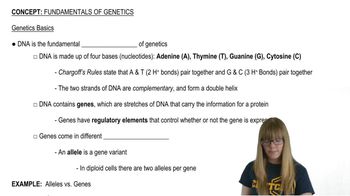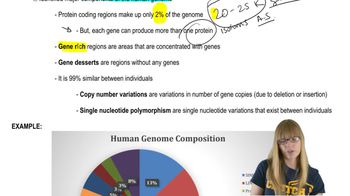Draw the chemical structure of a dinucleotide composed of A and G. Opposite this structure, draw the dinucleotide composed of T and C in an antiparallel (or upside-down) fashion. Form the possible hydrogen bonds.
Table of contents
- 1. Introduction to Genetics51m
- 2. Mendel's Laws of Inheritance3h 37m
- 3. Extensions to Mendelian Inheritance2h 41m
- 4. Genetic Mapping and Linkage2h 28m
- 5. Genetics of Bacteria and Viruses1h 21m
- 6. Chromosomal Variation1h 48m
- 7. DNA and Chromosome Structure56m
- 8. DNA Replication1h 10m
- 9. Mitosis and Meiosis1h 34m
- 10. Transcription1h 0m
- 11. Translation58m
- 12. Gene Regulation in Prokaryotes1h 19m
- 13. Gene Regulation in Eukaryotes44m
- 14. Genetic Control of Development44m
- 15. Genomes and Genomics1h 50m
- 16. Transposable Elements47m
- 17. Mutation, Repair, and Recombination1h 6m
- 18. Molecular Genetic Tools19m
- 19. Cancer Genetics29m
- 20. Quantitative Genetics1h 26m
- 21. Population Genetics50m
- 22. Evolutionary Genetics29m
7. DNA and Chromosome Structure
DNA Structure
Problem 16b
Textbook Question
Which of the following equations are true for the percentages of nucleotides in double-stranded DNA?
(A+T)/(G+C)=1.0
 Verified step by step guidance
Verified step by step guidance1
Understand Chargaff's rules: In double-stranded DNA, the amount of adenine (A) is equal to the amount of thymine (T), and the amount of guanine (G) is equal to the amount of cytosine (C). This is because A pairs with T and G pairs with C.
Express Chargaff's rules mathematically: A = T and G = C. Therefore, the total percentage of purines (A + G) equals the total percentage of pyrimidines (T + C).
Analyze the given equation: The equation (A + T)/(G + C) = 1.0 suggests that the sum of adenine and thymine is equal to the sum of guanine and cytosine in double-stranded DNA.
Consider the implications of Chargaff's rules: While A = T and G = C individually, the ratio (A + T)/(G + C) depends on the specific composition of the DNA and is not necessarily equal to 1.0. The ratio varies depending on the organism's genome.
Conclude the evaluation: Based on Chargaff's rules and the variability of nucleotide composition across different organisms, the equation (A + T)/(G + C) = 1.0 is not universally true for all double-stranded DNA.
 Verified video answer for a similar problem:
Verified video answer for a similar problem:This video solution was recommended by our tutors as helpful for the problem above
Video duration:
2mPlay a video:
Was this helpful?
Key Concepts
Here are the essential concepts you must grasp in order to answer the question correctly.
Chargaff's Rules
Chargaff's Rules state that in double-stranded DNA, the amount of adenine (A) is equal to thymine (T), and the amount of guanine (G) is equal to cytosine (C). This means that the percentages of A and T, as well as G and C, are complementary, leading to the conclusion that (A + T) should equal (G + C) in a given DNA sample.
Recommended video:
Guided course

Genetics Basics
Base Pairing
Base pairing refers to the specific hydrogen bonding between nucleotides in DNA, where adenine pairs with thymine (A-T) and guanine pairs with cytosine (G-C). This pairing is crucial for the stability of the DNA double helix and ensures accurate replication and transcription of genetic information.
Recommended video:
Guided course

Base Distortions
Nucleotide Composition
The nucleotide composition of DNA refers to the relative amounts of the four nucleotides (A, T, G, C) present in a DNA molecule. Understanding the composition is essential for analyzing genetic sequences and can provide insights into evolutionary relationships and species identification.
Recommended video:
Guided course

Human Genome Composition
Related Videos
Related Practice
Textbook Question
839
views


